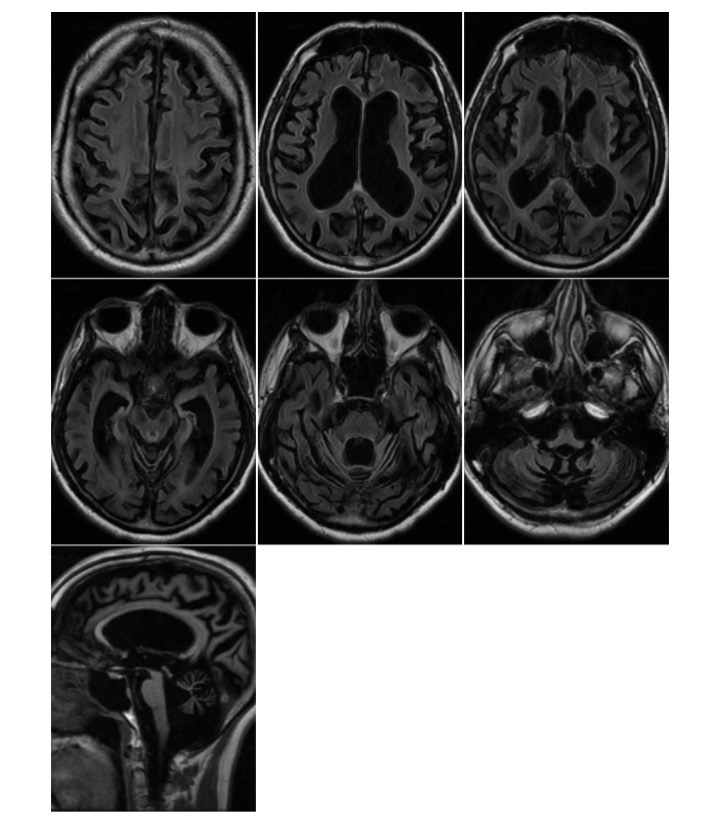Category: Rare Genetic and Metabolic Diseases
Objective: To delineate the clinical presentation, exam phenomenology, brain MRI findings and to review the literature of the first reported adult-onset case of ultrarare ERCC1 mutation.
Background: At the age of 29 years, the patient was found to have five hepatocellular carcinomatous (HCC) tumors for which he underwent orthotopic liver transplant. In his early thirties, he developed cognitive impairment followed by gait instability resulting in falls. Examination was notable for restricted extraocular movements that did not correct with oculocephalics, dysarthria, staccato speech, and marked appendicular and axial ataxia.
Method: As the patient was identified in clinic as having progressive cerebellar ataxia, he was referred to genetics. He and his parents were evaluated with whole exome sequencing (WES).
Results: MRI brain showed diffuse atrophy, predominantly in cerebellum (Fig 1). Whole-exome sequencing was pertinent for known pathogenic variant homozygous mutation in excision repair cross-complementation group 1 (ERRC1) gene at p.(Arg156Trp) (CGG>TGG): c.466 C>T in exon 4.
Conclusion: This is the first reported case of adult-onset manifestation of homozygous ERCC1 mutation and confirms previously reported ataxia phenomenology. ERCC1 gene is involved in nucleotide excision repair. Since only a few cases have been reported in the literature, homozygous ERCC1 mutation appears to be crucial to fetal survival. All previously reported cases manifested symptoms as infants or adolescents and had early-life deaths, unlike this patient. Based on human and animal evidence, cerebellar degeneration appears to be a clinical main feature.
References: 1. Tsodikov OV, Enzlin JH, Schärer OD, Ellenberger T. Crystal structure and DNA binding functions of ERCC1, a subunit of the DNA structure-specific endonuclease XPF-ERCC1. Proc Natl Acad Sci U S A. Aug 09 2005;102(32):11236-41. doi:10.1073/pnas.0504341102
2. Enzlin JH, Schärer OD. The active site of the DNA repair endonuclease XPF-ERCC1 forms a highly conserved nuclease motif. EMBO J. Apr 15 2002;21(8):2045-53. doi:10.1093/emboj/21.8.2045
3. Klein Douwel D, Boonen RA, Long DT, et al. XPF-ERCC1 acts in Unhooking DNA interstrand crosslinks in cooperation with FANCD2 and FANCP/SLX4. Mol Cell. May 08 2014;54(3):460-71. doi:10.1016/j.molcel.2014.03.015
4. Borgesius NZ, de Waard MC, van der Pluijm I, et al. Accelerated age-related cognitive decline and neurodegeneration, caused by deficient DNA repair. J Neurosci. Aug 31 2011;31(35):12543-53. doi:10.1523/JNEUROSCI.1589-11.2011
5. Niedernhofer LJ, Garinis GA, Raams A, et al. A new progeroid syndrome reveals that genotoxic stress suppresses the somatotroph axis. Nature. Dec 21 2006;444(7122):1038-43. doi:10.1038/nature05456
6. Weeda G, Donker I, de Wit J, et al. Disruption of mouse ERCC1 results in a novel repair syndrome with growth failure, nuclear abnormalities and senescence. Curr Biol. Jun 01 1997;7(6):427-39. doi:10.1016/s0960-9822(06)00190-4
7. Gregg SQ, Robinson AR, Niedernhofer LJ. Physiological consequences of defects in ERCC1-XPF DNA repair endonuclease. DNA Repair (Amst). Jul 15 2011;10(7):781-91. doi:10.1016/j.dnarep.2011.04.026
8. Jaspers NG, Raams A, Silengo MC, et al. First reported patient with human ERCC1 deficiency has cerebro-oculo-facio-skeletal syndrome with a mild defect in nucleotide excision repair and severe developmental failure. Am J Hum Genet. Mar 2007;80(3):457-66. doi:10.1086/512486
9. Kashiyama K, Nakazawa Y, Pilz DT, et al. Malfunction of nuclease ERCC1-XPF results in diverse clinical manifestations and causes Cockayne syndrome, xeroderma pigmentosum, and Fanconi anemia. Am J Hum Genet. May 02 2013;92(5):807-19. doi:10.1016/j.ajhg.2013.04.007
10. Apelt K, White SM, Kim HS, et al. ERCC1 mutations impede DNA damage repair and cause liver and kidney dysfunction in patients. J Exp Med. 03 01 2021;218(3)doi:10.1084/jem.20200622
11. Formica V, Doldo E, Antonetti FR, et al. Biological and predictive role of ERCC1 polymorphisms in cancer. Crit Rev Oncol Hematol. Mar 2017;111:133-143. doi:10.1016/j.critrevonc.2017.01.016
12. Kondo S, Mamada A, Miyamoto C, Keong CH, Satoh Y, Fujiwara Y. Late onset of skin cancers in 2 xeroderma pigmentosum group F siblings and a review of 30 Japanese xeroderma pigmentosum patients in groups D, E and F. Photodermatol. Apr 1989;6(2):89-95.
13. Doig J, Anderson C, Lawrence NJ, Selfridge J, Brownstein DG, Melton DW. Mice with skin-specific DNA repair gene (Ercc1) inactivation are hypersensitive to ultraviolet irradiation-induced skin cancer and show more rapid actinic progression. Oncogene. Oct 12 2006;25(47):6229-38. doi:10.1038/sj.onc.1209642
14. Sijbers AM, van Voorst Vader PC, Snoek JW, Raams A, Jaspers NG, Kleijer WJ. Homozygous R788W point mutation in the XPF gene of a patient with xeroderma pigmentosum and late-onset neurologic disease. J Invest Dermatol. May 1998;110(5):832-6. doi:10.1046/j.1523-1747.1998.00171.x
15. DiGiovanna JJ, Kraemer KH. Shining a light on xeroderma pigmentosum. J Invest Dermatol. Mar 2012;132(3 Pt 2):785-96. doi:10.1038/jid.2011.426
16. Olaussen KA, Mountzios G, Soria JC. ERCC1 as a risk stratifier in platinum-based chemotherapy for nonsmall-cell lung cancer. Curr Opin Pulm Med. Jul 2007;13(4):284-9. doi:10.1097/MCP.0b013e32816b5c63
17. Zhang C, Gao S, Hou J. ERCC1 expression and platinum chemosensitivity in patients with ovarian cancer: A meta-analysis. Int J Biol Markers. Dec 2020;35(4):12-19. doi:10.1177/1724600820963396
18. Hayashi M. Oxidative stress in developmental brain disorders. Neuropathology. Feb 2009;29(1):1-8. doi:10.1111/j.1440-1789.2008.00888.x
19. Switonski PM, Delaney JR, Bartelt LC, et al. Altered H3 histone acetylation impairs high-fidelity DNA repair to promote cerebellar degeneration in spinocerebellar ataxia type 7. Cell Rep. 11 30 2021;37(9):110062. doi:10.1016/j.celrep.2021.110062
20. Shiloh Y. The cerebellar degeneration in ataxia-telangiectasia: A case for genome instability. DNA Repair (Amst). 11 2020;95:102950. doi:10.1016/j.dnarep.2020.102950
21. Yau WY, O’Connor E, Sullivan R, Akijian L, Wood NW. DNA repair in trinucleotide repeat ataxias. FEBS J. 10 2018;285(19):3669-3682. doi:10.1111/febs.14644
22. Smith SC, Robinson AR, Niedernhofer LJ, Hetman M. Downregulation of cholesterol biosynthesis genes in the forebrain of ERCC1-deficient mice. Neurobiol Dis. Mar 2012;45(3):1136-44. doi:10.1016/j.nbd.2011.12.036
23. Liao X, Li Y, Li H, Huang W, Wang H, Xie W. Expression and Clinical Significance of ERCC1 and XPF in Human Hepatocellular Carcinoma. Onco Targets Ther. 2020;13:1059-1072. doi:10.2147/OTT.S237916
To cite this abstract in AMA style:
S. Radmard. First Report of ERCC1-Associated Adult-Onset Hepatocellular Carcinoma, Ataxia, and Cognitive Decline [abstract]. Mov Disord. 2023; 38 (suppl 1). https://www.mdsabstracts.org/abstract/first-report-of-ercc1-associated-adult-onset-hepatocellular-carcinoma-ataxia-and-cognitive-decline/. Accessed December 5, 2025.« Back to 2023 International Congress
MDS Abstracts - https://www.mdsabstracts.org/abstract/first-report-of-ercc1-associated-adult-onset-hepatocellular-carcinoma-ataxia-and-cognitive-decline/

